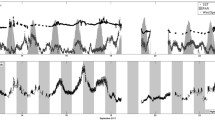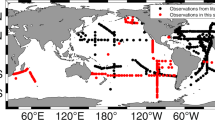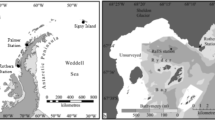Abstract
During the last decade the number of seawater dimethylsulfide (DMS) concentration measurements has increased substantially. The importance this gas, emitted from the ocean to the atmosphere, may have in the cloud microphysics and hence in the Earth albedo and radiation budget, makes it necessary to accurately reproduce the global distribution. Recently, the monthly global DMS climatology has been updated taking advantage of the threefold increased size and better resolved distribution of the observations available in the DMS database. Here, the emerging patterns found with the previous versions of the database and climatology are explored with the updated versions. The statistical relationships between the seasonalities of DMS concentrations and other variables are re-examined. The positive correlation previously found between surface seawater DMS and the daily-averaged climatological solar radiation dose in the upper mixed layer of the open ocean is confirmed with both the updated DMS database and climatology. Re-examination of the latitudinal match-mismatch between the seasonalities of DMS and phytoplankton, represented by the chlorophyll a concentration, reveals that they are highly positively correlated in latitudes higher than 40°, but anti-correlated in the 20°–40° latitudinal bands of both hemispheres. Overall, these global emerging patterns provide key information to further understanding the factors that control the emission of volatile sulfur from the ocean. The large uncertainties associated with the methodologies used in global computations, however, call for caution in using these emerging patterns as predictive tools, and prompt to the design of time series and process-oriented studies aimed at testing the validity of the observed relationships.






Similar content being viewed by others
References
Anderson TR, Spall SA, Yool A, Cipollini P, Challenor PG, Fasham MJR (2001) Global fields of sea surface dimethylsulfide predicted from chlorophyll, nutrients and light. J Mar Syst 30(1–2):1–20
Andreae MO, Crutzen PJ (1997) Atmospheric aerosols: biogeochemical sources and role in atmospheric chemistry. Science 276(5315):1052–1058
Aumont O, Belviso S, Monfray P (2002) Dimethylsulfoniopropionate (DMSP) and dimethylsulfide (DMS) sea surface distributions simulated from a global three-dimensional ocean carbon cycle model. J Geophys Res Oceans 107(C4):3029. doi:10.1029/1999JC000111
Bates TS, Lamb BK, Guenther A, Dignon J, Stoiber RE (1992) Sulfur emissions to the atmosphere from natural sources. J Atmos Chem 14:315–337
Bell TG, Poulton AJ, Malin G (2010) Strong linkages between dimethylsulphoniopropionate (DMSP) and phytoplankton community physiology in a large subtropical and tropical Atlantic Ocean data set. Glob Biogeochem Cycles 24:GB3009. doi:10.1029/2009GB003617
Belviso S, Moulin C, Bopp L, Stefels J (2004) Assessment of a global climatology of oceanic dimethylsulfide (DMS) concentrations based on SeaWiFS imagery (1998–2001). Can J Fish Aquat Sci 61(5):804–816. doi:10.1139/F04-001
Bopp L, Aumont O, Belviso S, Blain S (2008) Modelling the effect of iron fertilization on dimethylsulphide emissions in the southern ocean. Deep-Sea Res Pt II 55(5–7):901–912. doi:10.1016/j.dsr2.2007.12.002
Brock TD (1981) Calculating solar radiation for ecological studies. Ecol Model 14(1–2):1–19
Charlson RJ, Lovelock JE, Andreae MO, Warren SG (1987) Oceanic phytoplankton, atmospheric sulfur, cloud albedo and climate. Nature 326(6114):655–661
Dacey JWH, Howse FA, Michaels AF, Wakeham SG (1998) Temporal variability of dimethylsulfide and dimethylsulfoniopropionate in the Sargasso Sea. Deep-Sea Res Pt I 45(12):2085
Dasgupta S, Singh RP, Kafatos M (2009) Comparison of global chlorophyll concentrations using MODIS data. Adv Space Res 43(7):1090–1100. doi:10.1016/j.asr.2008.11.009
de Boyer Montégut C, Madec G, Fischer AS, Lazar A, Iudincone D (2004) Mixed layer depth over the global ocean: an examination of profile data and a profile-based climatology. J Geophys Res 109:C12003. doi:10.1029/2004JC002378
Derevianko GJ, Deutsch C, Hall A (2009) On the relationship between ocean DMS and solar radiation. Geophys Res Lett 36:L17606. doi:10.1029/2009GL039412
Elliott S (2009) Dependence of DMS global sea-air flux distribution on transfer velocity and concentration field type. J Geophys Res Biogeosci 114:G02001. doi:10.1029/2008JG000710
Galí M, Saló V, Almeda R, Calbet A, Simó R (2011) Stimulation of gross dimethylsulfide (DMS) production by solar radiation. Geophys Res Lett 38:L15612. doi:10.1029/2011GL048051
Halloran PR, Bell TG, Totterdell IJ (2010) Can we trust empirical marine DMS parameterisations within projections of future climate? Biogeosciences 7:1645–1656. doi:10.5194/bg-7-1645-2010
Kettle AJ, Andreae MO (2000) Flux of dimethylsulfide from the oceans: a comparison of updated data seas and flux models. J Geophys Res Atmos 105(D22):26793–26808
Kettle AJ, Andreae MO, Amouroux D, Andreae TW, Bates TS, Berresheim H, Bingemer H, Boniforti R, Curran MAJ, DiTullio GR, Helas G, Jones GB, Keller MD, Kiene RP, Leck C, Levasseur M, Malin G, Maspero M, Matrai P, McTaggart AR, Mihalopoulos N, Nguyen BC, Novo A, Putaud JP, Rapsomanikis S, Roberts G, Schebeske G, Sharma S, Simó R, Staubes R, Turner S, Uher G (1999) A global database of sea surface dimethylsulfide (DMS) measurements and a procedure to predict sea surface DMS as a function of latitude, longitude, and month. Glob Biogeochem Cycles 13(2):399–444
Kiehl JT, Trenberth KE (1997) Earth’s annual global mean energy budget. B Am Meteorol Soc 78(2):197–208
Kiene RP, Kieber DJ, Slezak D, Toole DA, del Valle DA, Bisgrove J, Brinkley J, Rellinger A (2007) Distribution and cycling of dimethylsulfide, dimethylsulfoniopropionate, and dimethylsulfoxide during spring and early summer in the Southern Ocean south of New Zealand. Aquat Sci 69(3):305–319. doi:10.1007/s00027-007-0892-3
Lana A, Bell TG, Simó R, Vallina SM, Ballabrera-Poy J, Kettle AJ, Dachs J, Bopp L, Saltzman ES, Stefels J, Johnson JE, Liss PS (2011) An updated climatology of surface dimethlysulfide concentrations and emission fluxes in the global ocean. Glob Biogeochem Cycles 25(1):GB1004. doi:10.1029/2010GB003850
Le Clainche Y, Vecina A, Levasseur M, Cropp R, Gunson J, Vallina SM, Vogt M, Lancelot C, Allen I, Archer S, Bopp L, Deal C, Elliott S, Jin M, Malin G, Schoemann V, Simó R, Six K, Stefels J (2010) A first appraisal of prognostic ocean DMS models and prospects for their use in climate models. Glob Biogeochem Cycles 24:GB3021. doi:10.1029/2009GB003721
Locarnini RA, Mishonov AV, Antonov JI, Boyer TP, Garcia HE, Baranova OK, Zweng MM, Johnson DR (2010) World Ocean Atlas 2009, volume 1: temperature. In: Levitus S (ed) NOAA Atlas NESDIS. 68. U.S. Government Printing Office, Washington DC, p 184
Longhurst A (1998) Ecological geography of the sea. Academic Press, London
Miles CJ, Bell TG, Lenton TM (2009) Testing the relationship between the solar radiation dose and surface DMS concentrations using in situ data. Biogeosciences 6:1927–1934
Simó R (2001) Production of atmospheric sulfur by oceanic plankton: biogeochemical, ecological and evolutionary links. Trends Ecol Evol 16(6):287–294
Simó R (2004) From cells to globe: approaching the dynamics of DMS(P) in the ocean at multiple scales. Can J Fish Aquat Sci 61(5):673–684. doi:10.1139/F04-030
Simó R, Dachs J (2002) Global ocean emission of dimethylsulfide predicted from biogeophysical data. Glob Biogeochem Cycles 16(4):1078
Simó R, Pedrós-Alió C (1999) Role of vertical mixing in controlling the oceanic production of dimethyl sulphide. Nature 402(6760):396–399
Six KD (2006) What controls the oceanic dimethylsulfide (DMS) cycle? A modeling approach. Glob Biogeochem Cycles 20(4):GB4011. doi:10.1029/2005GB002674
Stefels J (2000) Physiological aspects of the production and conversion of DMSP in marine algae and higher plants. J Sea Res 43(3–4):183–197
Sunda W, Kieber DJ, Kiene RP, Huntsman S (2002) An antioxidant function for DMSP and DMS in marine algae. Nature 418(6895):317–320
Toole DA, Siegel DA (2004) Light-driven cycling of dimethylsulfide (DMS) in the Sargasso Sea: closing the loop. Geophys Res Lett 31(9):L09308. doi:10.1029/2004GL019581
Vallina SM, Simó R (2007a) Strong relationship between DMS and the solar radiation dose over the global surface ocean. Science 315(5811):506–508. doi:10.1126/science.1133680
Vallina SM, Simó R (2007b) Re-visiting the CLAW hypothesis. Environ Chem 4:384–387. doi:10.1071/EN07055
Vallina SM, Simó R, Gasso S (2006) What controls CCN seasonality in the southern ocean? A statistical analysis based on satellite-derived chlorophyll and CCN and model-estimated OH radical and rainfall. Glob Biogeochem Cycles 20(1):B1014. doi:10.1029/2005GB002597
Vallina SM, Simó R, Gasso S, de Boyer-Montegut C, del Rio E, Jurado E, Dachs J (2007) Analysis of a potential ‘solar radiation dose-dimethylsulfide-cloud condensation nuclei’ link from globally mapped seasonal correlations. Glob Biogeochem Cycles 21(2):B2004. doi:10.1029/2006GB002787
Vila-Costa M, Kiene RP, Simó R (2008) Seasonal variability of the dynamics of dimethylated sulfur compounds in a coastal northwest Mediterranean site. Limnol Oceanogr 53:198–211
Vogt M, Vallina SM, Buitenhuis ET, Bopp L, Le Quere C (2010) Simulating dimethylsulphide seasonality with the dynamic green ocean model PlankTOM5. J Geophys Res 115:C06021. doi:10.1029/2009JC005529
Acknowledgments
The authors want to thank each of the individual contributors that generously submitted their DMS data to the Global Surface Seawater Dimethylsulfide Database, and to J.E. Johnson and T.S. Bates for the maintenance of the database. We thank M. Galí and the two reviewers for their helpful comments. We thank the Ocean Biology Processing Group at GSFC for the production and distribution of the monthly chlorophyll a data. This work was supported by the Spanish Ministry of Science and Innovation through the projects MIMOSA, PRISMA and Malaspina 2010, and through a PhD studentship to A.L.
Author information
Authors and Affiliations
Corresponding author
Rights and permissions
About this article
Cite this article
Lana, A., Simó, R., Vallina, S.M. et al. Re-examination of global emerging patterns of ocean DMS concentration. Biogeochemistry 110, 173–182 (2012). https://doi.org/10.1007/s10533-011-9677-9
Received:
Accepted:
Published:
Issue Date:
DOI: https://doi.org/10.1007/s10533-011-9677-9




